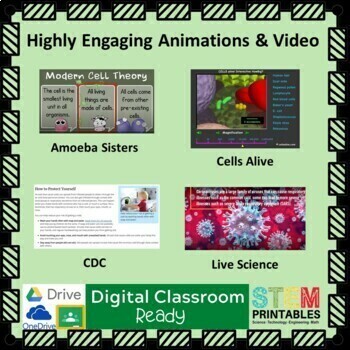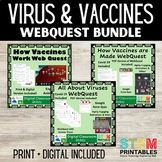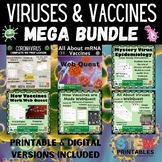All About Viruses Webquest - Cell Biology & Immune System | Digital Version

Also included in
- Updated! This web quest bundle makes a great activity to introduce the topics of viruses, how vaccines are made, and the body's immune response. It also is perfect for an emergency sub lesson! I've included a variety of engaging video and website resources from: Ask a Biologist, Cells Alive, AmoebPrice $5.75Original Price $8.50Save $2.75
- This is the ultimate mega bundle that contains literally everything you need to teach your students all about viruses and vaccines, including COVID-19. Print & Digital versions are included so you can have students learn in a variety of learning modes: Teacher Led Instruction with PPT/Google SliPrice $13.00Original Price $19.50Save $6.50
Description
Updated! This webquest makes a great activity to introduce the topics of viruses and the body's immune response. It also is perfect for an emergency sub lesson! I've included a variety of engaging video and website resources from: Ask a Biologist, Cells Alive, Amoeba Sisters, CDC, and Live Science. - Answer Key Included!
This web quest consists of 4 pages plus a 20 question Google Form Quiz! Students will enjoy watching engaging videos, using an interactive microscope simulation, and informative websites.
Updated 1/6/2024: This product contains the most current information regarding new Covid-19 virus mutations (CDC Website), and current vaccine effectiveness against new strains.
Topics Included
- Structure of a typical virus
- Modern Cell Theory
- Bacteriophage
- Lytic Cycle
- Lysogenic Cycle
- Immune System Response
- Leukocytes
- Helper T-Cells
- HIV Virus
- Influenza Virus
- Respiratory Sincitial Virus
- Human Parainfluenza Virus
- Adenoviruses
- Coronaviruses
- Severe Acute Respiratory Syndrome (SARS) Virus
- Wuhan Novel Coronavirus (COVID-19)
Looking for a No-Prep Lesson on the COVID-19 Coronavirus?
- What is a Coronavirus No-Prep Mini-Lesson
- What is a Coronavirus No-Prep Mini-Lesson - Google Classroom Version
Tips for Customers
- Click the Green ★ to follow our store and get notifications of freebies and new products!
- Leave feedback to receive TpT credit for use on future purchases.
- Questions? Please contact us in the Product Q&A Section.
Terms of Use
All rights reserved by STEM Printables
This product is intended for use by the original purchaser only.
Sharing this product with others, distributing via any means, or posting online is strictly prohibited.
Failure to comply is a copyright infringement and a violation of the Digital Millennium Copyright Act (DMCA). Clipart and elements found in this PDF are copyrighted and cannot be extracted and used outside of this file without permission or license.





